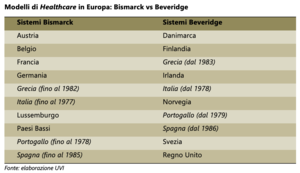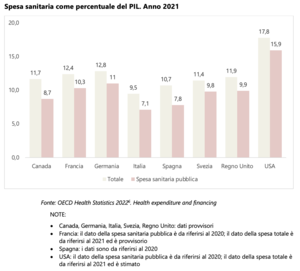Come va la salute? 45 anni di Servizio Sanitario Nazionale: costi e performance (e qualche confronto con gli altri Paesi)

In principio c'erano le casse mutue. E il diritto alla salute sancito dall'articolo 32 della Costituzione non era per tutti: ne godevano solo quei lavoratori (e i loro familiari) iscritti a un ente mutualistico, con forti differenze, in fatto di prestazioni e coperture, tra una categoria di lavoratori e l'altra.
Solo nel 1978, con la nascita del servizio sanitario nazionale su un modello di welfare state universalistico - il sistema Beveridge, finanziato prevalentemente attraverso la fiscalità generale - la tutela della salute fisica e psichica è diventata un diritto da garantire a ogni individuo in condizioni di uguaglianza.
Ma il nostro SSN costa più o meno dei servizi sanitari di altri Paesi che hanno adottato modelli diversi, ad esempio il sistema Bismarck? E cosa ci dicono gli indicatori di performance?
Con una spesa sanitaria pubblica pari al 7,1% del PIL, l'Italia nel 2020 risultava terza, fra i Paesi europei comparati, per numero di posti letto ospedalieri (3,19 ogni 1000 abitanti), e faceva registrare la più bassa disponibilità di strutture residenziali destinate agli anziani. Altre classifiche - dall'aspettativa di vita alla nascita (83 anni) all'aspettativa di vita in salute (71,9 anni) - ci vedono al vertice. Merito anche degli stili di vita.
How's your Health? Italy’s NHS turns 45: costs and performance (and some comparisons with other countries)
Initially, Italy had the casse mutue health insurance system. The right to health, established under Article 32 of the Italian Constitution, was not enjoyed by everyone, but only by those workers (and their families) who had signed up with the insurance fund. In addition,there were considerable differences between the several class of workers in terms of benefits and coverage.
Only in 1978, with the institution of the National Health Service based on the universal welfare state model - the Beveridge system, chiefly funded through taxation - did the protection of physical and mental health become a right to be truly enjoyed by all individuals on equal terms.
But does Italian NHS cost more or less than those set up by countries that adopted different models, such as the Bismarck model? And what do the performance indicators tell us?
In 2020, with a public health expenditure of 7.1% of GDP, Italy ranked third - among the European countries of the comparison - in terms of number of hospital beds (3.19 per 1,000 inhabitants), and had the lowest availability of residential care homes for the elderly. Other categories - such as life expectancy at birth (83 years) and healthy life expectancy (71.9 years) - see Italy at the top. Credit for this also goes to lifestyles.







 Focus
Focus